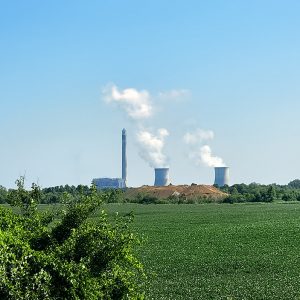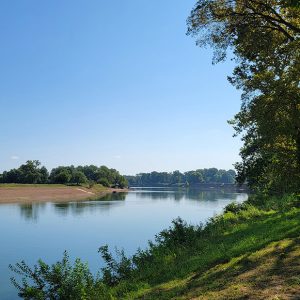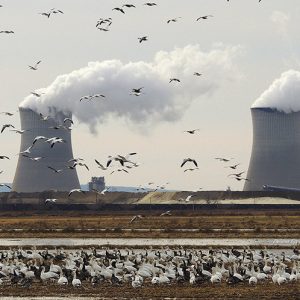calsfoundation@cals.org
Independence Steam Electric Station
The Independence Steam Electric Station (ISES) is a coal-fired electric-energy-generating plant consisting of two units nameplate-rated at 850 megawatts (MW). Located near Newark (Independence County), the units—constructed by Arkansas Power and Light Company (AP&L, now Entergy Arkansas)—were launched into service in 1983 and 1984 following vigorous litigation before the Arkansas Public Service Commission (APSC) in 1978.
The ISES plant burns Powder River Basin low-sulfur coal transported to Arkansas from the Antelope Coal Mine in Wyoming by rail in cars owned by Entergy. ISES—originally proposed by AP&L, Arkansas Electric Cooperative Corporation (AECC), and City Water and Light (CWL) of Jonesboro (Craighead County), and now also co-owned or leased by several other Arkansas municipal utilities—operates in coordination with other generating plants within the Entergy system in portions of Arkansas, Louisiana, Mississippi, and Texas. The plant has a 1,000-foot smokestack.
On December 14, 1977, AP&L filed an application for a certificate of environmental compatibility and public need for the ISES units pursuant to Arkansas’s Utility Facility Environmental and Economic Protection Act of 1973. As with AP&L’s earlier proposal to build the White Bluff Generating Plant, the application to construct and operate ISES generated controversy, with Attorney General Bill Clinton intervening in the APSC proceeding in January 1978.
Following extensive discovery requests by the attorney general—including detailed AP&L responses to questions prepared with the assistance of the Environmental Defense Fund (EDF) and its senior attorney, David B. Roe—Clinton’s office filed the responsive testimony of EDF senior economist witnesses Zachary Willey and Daniel Kirshner. Using a utility expansion computer model developed by EDF and reliant on the data supplied by AP&L in response to data requests, the attorney general’s witnesses testified that, through the development and implementation of a portfolio of energy-efficiency technologies (weatherization, insulation, electric load management, voltage regulation, and industrial cogeneration of electricity) and limited renewable resources such as passive solar water heating, AP&L could displace the need for at least one and perhaps both of the two Independence units.
AP&L and its witnesses and lawyers vehemently contested these “soft-path” alternative technologies to reduce the need for the 1,700 MW of capacity the ISES units would produce by the year 1985 (when both units would be online). Hearings on the AP&L application were held in late May and concluded on June 6, 1978 (one week after Bill Clinton won the Democratic nomination for governor), with an APSC-requested appearance by Clinton to respond to questions concerning his advocacy of this alternative path for utility planning.
At the hearing, Clinton confirmed his belief that the evidence produced by the EDF witnesses was sufficient to support approving a certificate for, at most, one of the ISES units. When one of the commissioners observed that, because of the APSC’s small work force and the fact that its decisions “tend to be ad hoc responses to things that utilities do,” the commission was “handicapped in our ability to formulate and implement long range policies which I think we really need in the energy conservation area,” Clinton responded with the following:
Well, I agree with you but let me put it another way back to you. In this siting case your approval of this Application under these circumstances, right or wrong, is in effect making long range energy policies for the State of Arkansas, is in effect making a very large capital investment decision not only for the utilities involved but for the people of Arkansas eventually. So that if in this context whether you have the staff or not, you have made a decision of that magnitude in that area.
Following the hearing, the parties submitted simultaneous legal briefs on June 30, 1978, arguing for and against the granting of the certificate and citing the testimony filed by party witnesses. AP&L presented arguments in support of its position on the utilities’ load forecasts, the need to reduce dependence on oil-fired generation, and the need for generating reserves of at least sixteen percent. It also presented arguments on the inability of transmission reliability upgrades to substitute for generating reserves, the cost of a shortage of generating capacity, the inability of increased participation in the Grand Gulf nuclear plant (then under construction) to eliminate the need for ISES, the environmental compatibility of ISES, and the acceptability of AP&L’s projected economic impact of the plant. However, the company’s most vociferous attack was reserved for Willey’s “alleged alternatives” to the construction of ISES.
On August 31, 1978, by Order No. 7 in the ISES docket, the commission granted AP&L, AECC, and CWL a Certificate of Environmental Compatibility and Public Need to construct the Independence plant. The commission stated that, although it preferred the “soft path,” it found that AP&L’s projection of its peak load was a reasonable estimate of its later capacity needs and thus was not convinced that the alternative resources could be developed in time to avoid the forecasted need for either of the coal-fired units. Notwithstanding its decision to grant the certificate, the commission declared its intention to explore further the potential of soft-path alternatives to power plant construction. Construction began soon after this approval. Unit 1 went online in 1983 and Unit 2 in 1984.
On November 25, 2014, the Arkansas Department of Environmental Quality and the Arkansas Public Service Commission filed joint comments with the Environmental Protection Agency (EPA) in its Clean Power Plan docket addressing the EPA’s proposed rules under Section 111(d) of the Clean Air Act that would require states to control greenhouse gas emissions from existing electric-energy-generating units such as ISES. According to the comments, the White Bluff and Independence facilities were seeking permits for environmental controls to ensure compliance with EPA’s mercury and air toxics rules. In 2018, the Sierra Club and the National Parks Conservation Association sued Entergy for violation of the Clean Air Act, and later that year, Entergy announced that the Independence plant would cease burning coal by 2030. A settlement announced in 2021 also stipulated that Entergy would begin using low-sulfur coal at both White Bluff and the Independence plants by June 30, 2021.
For additional information:
Eley, Ashton. “In Settlement, Power Plants to Shut by ’30.” Arkansas Democrat-Gazette, March 12, 2021, pp. 1B, 5B.
“EPA Backs Statement by AP&L.” Arkansas Gazette, November 16, 1978, p. 17A.
Griffee, Carol. “PSC Approves AP and L Plant Near Newark.” Arkansas Gazette, September 1, 1978, pp. 1A, 2A.
“Newark and Beyond.” Arkansas Gazette, September 4, 1978, p. 22A.
Roe, David B. Dynamos and Virgins: An Advocate’s Personal Account of the Struggle to Force a New Idea, and a New Future, on the Nation’s Power Companies. New York: Random House, 1984.
Transcript of June 6, 1978, hearing in Docket No. 77-003-U, Document No. 85, at 3231-3232. Arkansas Public Service Commission. http://www.apscservices.info/EFilings/Docket_Search_Documents.asp?Docket=77-003-U&DocNumVal=85 (accessed September 9, 2021).
Wally Nixon
Jacksonville, Arkansas



 Coal Train
Coal Train  Coal-Fired Power Plant
Coal-Fired Power Plant  Independence Steam Electric Station
Independence Steam Electric Station  Oil Trough Park
Oil Trough Park  Snow Geese at Paroquet
Snow Geese at Paroquet 



Comments
No comments on this entry yet.